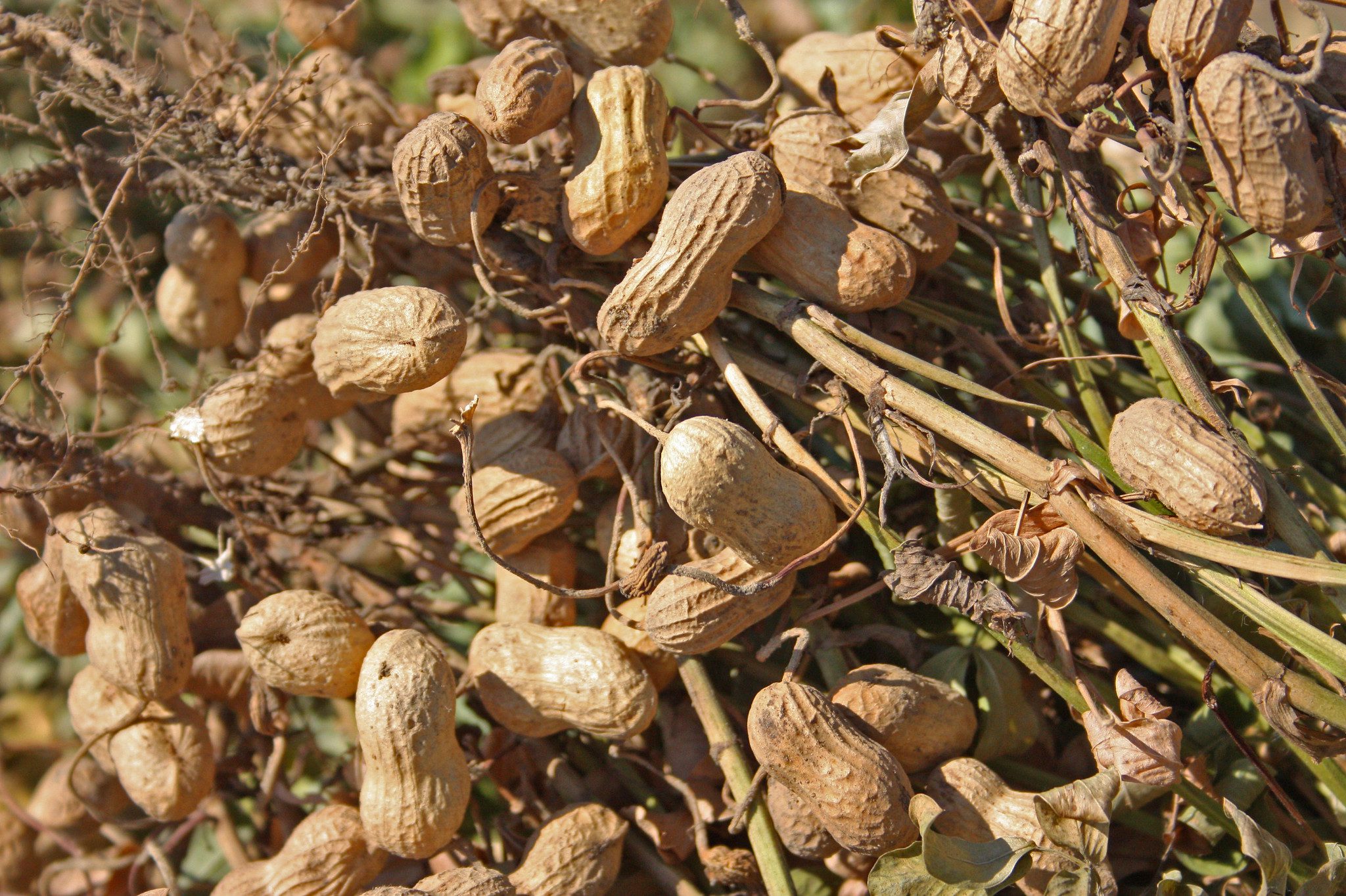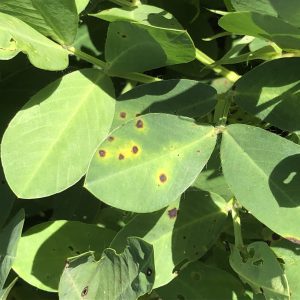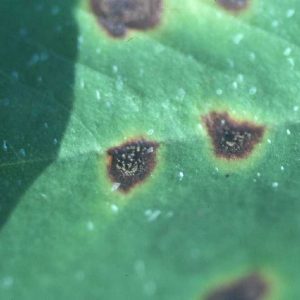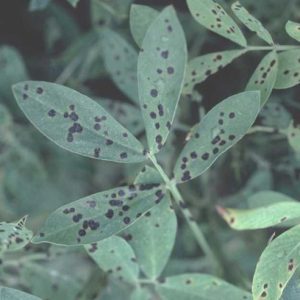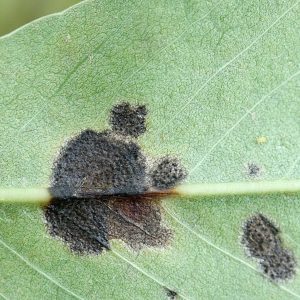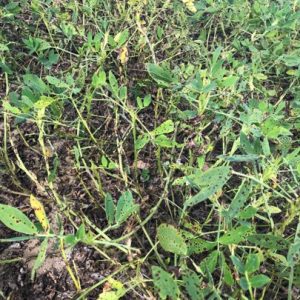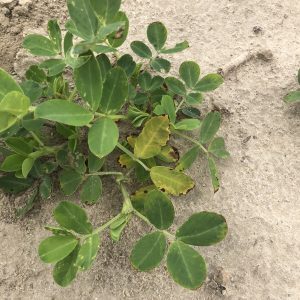Crop Production

Leaf spots and peanut rust are significant fungal diseases of peanuts in Alabama. Adopting integrated pest management (IPM) strategies can reduce losses.
Early and Late Leaf Spot
Early and late leaf spot are the most destructive fungal diseases of peanuts in Alabama. Historically, peanut harvesting in Alabama began when all the peanuts in a field were stripped of their leaves by one or both diseases.
Over the years, improvements in fungicide efficacy have resulted in sizable gains in pod yield and quality. Depending on weather conditions, annual losses due to early and late leaf spot still range between 5 and 10 percent of Alabama’s total peanut crop. If not controlled, early and late leaf spot can cause premature defoliation and reduce pod yields by 50 percent or more.
Distribution
Early leaf spot, caused by Passalora arachidicola (previously known as Cercospora arachidicola), is the most common leaf spot disease in central Alabama. Late leaf spot, caused by Nothopassalora personata (previously known as Cercosporidium personatum), is predominant in southwest Alabama. Both leaf spot diseases are found in southeast Alabama. Early leaf spot is usually seen in Alabama peanut fields well before late leaf spot has made its appearance.
Prevailing weather patterns, variety selection, and other management inputs influence the year-to-year occurrence of both leaf spot diseases. In 2020 and 2021, late leaf spot was observed late in the season in peanuts grown in central Alabama.
Symptoms and Signs
Early leaf spot is characterized by circular spots that are brown to reddish brown on the upper leaf surface and almost orange on the lower leaf surface. Lesions typically have a bright yellow halo and are about the diameter of a no. 2 pencil (figure 1). They often appear smooth on both leaf surfaces as the causal fungus produces relatively few spores.
During periods of heavy cloud cover and frequent showers, masses of clear to olive-colored spores may be seen using a hand lens on the upper leaf surface of a lesion (figure 2). Early leaf spot can be found as early as mid-to-late May on the leaves of peanuts planted in late April.
Late leaf spot lesions range in color from dark brown to almost black and have a feathery margin. They usually are similar in size and shape to those of early leaf spot (figure 3). Spots may or may not be surrounded by a yellow halo typically seen in June and early July. Because late leaf spot fungus produces many spores on lower leaf surfaces, the lesions usually have a raised or tufted appearance (figure 4). Late leaf spot typically is observed in mid-to-late August, but it can appear as early as late June to early July if it is the predominant leaf spot disease.
- Figure 1. Early leaf spot on peanuts
- Figure 2. Olive-colored spores on upper surface of early leaf spot lesions
- Figure 3. Dark brown to black late leaf spot lesions
- Figure 4. Dark brown to black late leaf spot lesions with masses of spores on lower leaf surface
- Figure 5. Premature leaf shed caused by leaf spot diseases may result in substantial losses in peanut yield and grade.
- Figure 6. Phorate damage in peanut seedlings
Early and late leaf spot first appear on leaves as small yellow to brown flecks. In some locations, spots of both diseases may be seen on the same leaflets. These spots may be similar in color on severely damaged peanuts but are larger and commonly seen on the leaf petiole and central and lateral stems. Similarities in spot color on some peanut cultivars can make early and late leaf spot difficult to distinguish.
Badly spotted leaves often fall to the ground well before harvest (figure 5). Leaf shed usually starts at the base of the central or lateral stem and continues upward until all but the youngest leaves at the shoot tips are lost. In severely damaged fields, a thick carpet of fallen leaves often litters the ground around the base of the bare-stemmed peanut plant.
Badly defoliated peanut plants can shed numerous pods as the weakened pegs break when the plants are dug and inverted. The earlier that defoliation begins, the greater the yield loss. To avoid such heavy yield losses, peanuts defoliated by leaf spot may have to be dug well before their expected maturity date.
Leaf spot diseases can be difficult to differentiate from spots caused by soil and foliar-applied pesticides. Pesticide injury is usually seen on new growth, while leaf spot symptoms are more prevalent on mature leaves. Injury from soil-applied pesticides, especially insecticides, appears as brown to reddish brown spots scattered along the margins of leaves of peanut seedlings (figure 6). White areas of pesticide residue are often seen in the center of the spots. Injury from foliar-applied pesticides typically appears within a day or two of application.
Disease Cycle
Early and late leaf spot fungi overwinter between peanut crops on undecomposed leaf and stem debris. Old lesions on peanut debris can produce spores that infect the new peanut crop or peanut volunteers. While most inoculum is local, spores can spread from neighboring fields by wind and over long distances by tropical storms.
Temperatures between 65 and 90 degrees F, frequent showers, and prolonged periods of leaf wetness caused by heavy dew or fog favor infection. Irrigated fields are at higher risk for leaf spot than fields under dry-land production. Weather patterns favoring foliage infection are also conducive to spore production by both leaf spot fungi.
Lesions typically become visible at 10 to 14 days after infection. The higher reproductive rate of N. personata means that late leaf spot usually spreads more rapidly than does early leaf spot.
Management Practices
Early and late leaf spot are significant threats to peanuts in Alabama. Losses can be reduced by adopting integrated pest management (IPM) strategies.
Plant a Resistant Cultivar
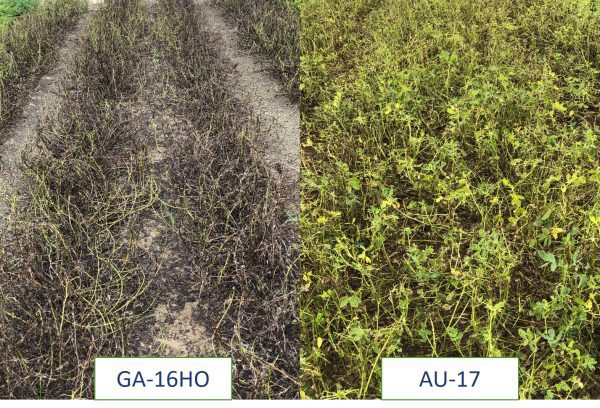
Figure 7. Peanut cultivars vary in susceptibility to leaf spot diseases (Georgia 16HO is susceptible; AU NPT 17 is tolerant). This shows premature leaf shed caused by late leaf spot in untreated peanuts.
Peanut cultivars vary in susceptibility to both early and late leaf spot (figure 7). Selecting peanut cultivars with partial resistance to one or both leaf spot diseases is an effective disease management tactic.
When selecting cultivars, consider the risk of other pests, such as tomato spotted wilt (TSW), root-knot nematodes, and white mold. AU NPL 17, Georgia-12Y, Georgia-14N, and TifNV-High O/L have partial resistance to leaf spot diseases but vary in resistance to other pests. Although cultivars with partial resistance still need some fungicide protection, total fungicide inputs can be reduced to maintain optimum yield.
When selecting a fungicide spray program, it is important to know the risk factor for leaf spot associated with your field. The Peanut Rx Guide website, developed by the University of Georgia in cooperation with Auburn University, the University of Florida, and Mississippi State University, can be used to update yearly.
Practice Crop Rotation and Eliminate Peanut Volunteers
Peanut is the only known host for both early and late leaf spot. Maintaining a rotation schedule of 3 to 4 years between peanut crops allows the leaf and stem debris from the previous peanut crop time to decompose, thus minimizing carryover of both leaf spot fungi. Rotation is also useful in delaying initial infections, thereby slowing further disease spread for the rest of the growing season.
The fungal pathogens that cause leaf spot diseases in peanuts can survive from one season to the next on volunteer peanuts. Thus, a critical component of a successful rotation program eliminating volunteer peanuts in the field or forage crops that follow peanuts immediately after the peanut harvest in the fall.
Consider Tillage Practices
Tillage practices can make a big difference in peanut yield and can affect disease pressure. Conservation tillage, such as strip tillage, can reduce leaf spot pressure compared to fields with conventional tillage.
With conservation tillage, the appearance of leaf spot is delayed in strip-tilled fields, and severity at the end of season is significantly lower if peanut is not planted in consecutive seasons. The need for fungicides is not eliminated but can provide added leaf spot control. Strip/reduced tillage also can reduce thrips pressure and suppress TSW, but some research has shown an increase in white mold pressure compared to conventional tillage. Deep turning the soil from the previous peanut may help reduce white mold pressure.
Consider Planting Date
In fields prone to leaf spot, early planting (late April to early May) can help slow disease spread and reduce severity. Leaf spot risk increases as planting dates move to late May and June. Warm temperatures later in the season are more conducive to fungal growth and sporulation, which increase levels of inoculum and facilitate spread of leaf spot pathogens. Planting early reduces the amount of time peanuts are exposed to higher inoculum levels later in the season. The occurrence of tropical storms late in the season can delay fungicide applications and harvest, which also increases leaf spot risk in late-planted peanuts.
Apply Fungicides Preventively
Fungicides must be applied preventively to control leaf spot diseases and produce optimum peanut yields. Leaf spot diseases can cause yield losses of 50 percent or more in nontreated peanuts.
Several fungicides labeled for use on peanuts in Alabama can be incorporated into a spray program to control early and late leaf spot. For current recommended fungicide options, see Peanut IPM Guide (Extension publication IPM-0360). Also consult the Peanut Rx Guide website to determine the risks associated with your field and to plan fungicide spray programs accordingly.
Fungicide applications can be scheduled according to field risk, the calendar, and/or a weather-based spray advisory, such as AU-PNUT. Fungicide applications should begin approximately 30 days after planting (DAP), but no later than 45 DAP.
Subsequent application intervals depend on the length of the effective protective interval of the previous fungicide application. Most fungicides should be reapplied every 14 days or according to the advisory tool; however, some fungicides provide leaf spot protection for 21 to 28 days. A final application, typically chlorothalonil, at 120 DAP usually provides control until harvest date. An additional fungicide application may be needed if you are more than 2 weeks away from your projected dig date and conditions are favorable for disease development or leaf spot is present. When selecting fungicides late in the season, check the product label for the preharvest interval (PHI).
Weather patterns do not always favor development of leaf spot diseases on peanut. Extended periods of hot, dry weather will slow development of either early or late leaf spot in dry-land peanuts. Leaf spot fungicides applied during such long dry spells may be wasted.
Weather-based spray advisories, such as AU-PNUT, can provide disease control similar to that of a 14-day calendar spray program but with generally fewer fungicide applications and at less cost to the producer. Under the AU-PNUT advisory, the decision about whether to apply a fungicide is based on the number of showers and the 5-day rainfall forecast. AU-PNUT requires producers to check and record daily rainfall totals for each field routinely. For more information on AU-PNUT, see Peanut IPM Guide (Extension publication IPM-0360).
No fungicide spray program is foolproof. Regardless of the method used to schedule fungicide applications, fields must be checked every 1 to 2 weeks starting at 60 DAP until harvest.
Resistance management is a concern since repeated use of selective fungicides can increase the risk for fungicide resistance in early and late leaf spot fungi. Selective fungicides are placed in different Fungicide Resistance Action Committee (FRAC) groups according to their mode of action and resistance risk. The most-used fungicides for leaf spot control in Alabama belong to FRAC groups 3, 7, and 11, which carry a medium or high risk for fungicide resistance development. To prevent fungicide resistance, mix or alternate fungicides from different FRAC groups, and use nonselective (such as group M) fungicides for two or more sprays per season. See product labels for more information.
Peanut Rust
Peanut rust, caused by Puccinia arachidis, occurs sporadically on peanuts in Alabama. If left uncontrolled, peanut rust can cause significant reductions in pod yield, and the presence of leaf spot can exacerbate losses. Widespread use of chlorothalonil fungicides has kept problems with peanut rust to a minimum in the southeastern United States.
Distribution
Outbreaks of this disease are mostly seen beginning in late July to early August in south Alabama. Prevailing weather patterns can influence the year-to-year occurrence of rust.
Symptoms
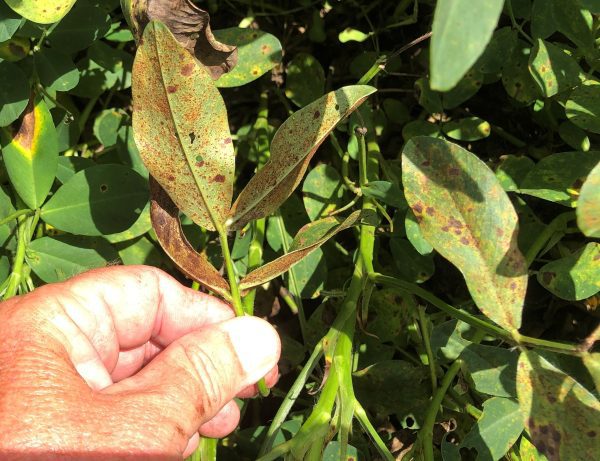
Figure 8. Orange rust pustules clearly visible on the undersides of leaves
Peanut rust is easily identified by the appearance of numerous tiny, reddish-orange pustules on the undersides of the leaflets (figure 8). Pustules also can form on petioles, stems, and pegs. The ruptured pustules contain masses of powdery, orange spores. Although badly diseased leaflets quickly turn light brown and die, they often remain attached to the plant.
When left unchecked, diseased peanut plants appear scorched, quickly die, and shed most mature pods. Because they mature 2 to 3 weeks early, any remaining pods harvested have low test weights.
Disease Cycle
P. arachidis is highly host specific and can survive only on green plant tissue and in areas where its host is not killed by frost. Thus, spores of the peanut rust fungus are short-lived and do not survive from year to year on peanut crop debris.
This fungus is moved into Alabama from Central America by weather systems, especially tropical storms, and hurricanes. Extended periods of cloudy, wet weather and temperatures of 68 to 86 degrees F favor the appearance of rust on peanut.
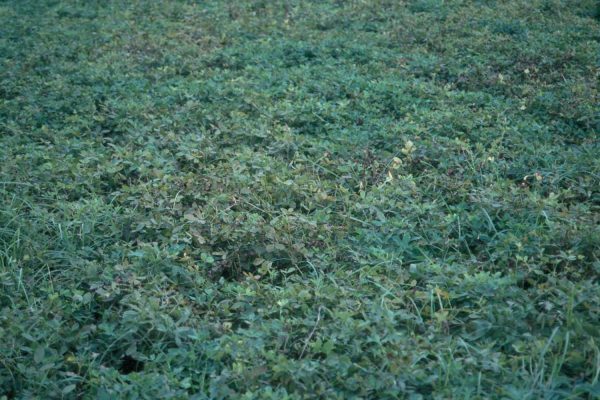
Figure 9. Rust hot spot in a peanut field
Peanut rust first appears on one to several plants in scattered focal points or “hot spots” across a field of peanuts (figure 9). These hot spots of peanut rust are easily mistaken for spider mite damage. Under favorable weather conditions, new infections can occur every 7 to 20 days, and the disease can quickly spread until the field is destroyed. Epidemics of peanut rust develop faster than those of early or late leaf spot.
Control
Most of the management practices that are useful in slowing the spread of leaf spot diseases in peanut are ineffective against rust. However, losses can be reduced by adopting specific Integrated Pest Management (IPM) strategies.
Consider Planting Date
Since rust does not appear until late summer, disease outbreaks may be avoided by planting a short-season peanut cultivar in late April. Late-planted peanuts should not be sown near fields planted earlier in the season.
Apply Fungicides
Under favorable weather conditions, failure to start an intensive fungicide spray program allows rust to spread rapidly until the field is destroyed. Fungicides applied according to a recommended calendar or weather-based spray schedule, such as AU-PNUT, generally control peanut rust.
Many fungicide products used to control leaf spot also have excellent activity against rust; these include chlorothalonil, azoxystrobin, pyraclostrobin, and tebuconazole. Application intervals should be shortened, however, as peanut rust requires more frequent fungicide applications than are required for leaf spot.
Beginning in late July, check fields in rust-prone areas weekly for peanut rust hot spots. Pay particular attention to areas of peanuts with off-color or yellow foliage. If rust is found, apply the full rate of a recommended fungicide every 7 days until 2 weeks before harvest. See currently recommended fungicide options in the “Peanut IPM Guide” (IPM-0360) on the Alabama Extension website at www.aces.edu.
 Amanda Strayer-Scherer, Extension Plant Pathologist, Assistant Professor, Entomology and Plant Pathology, and Kris Balkcom, Assistant Extension Professor, Crop, Soil, and Environmental Sciences, both with Auburn University
Amanda Strayer-Scherer, Extension Plant Pathologist, Assistant Professor, Entomology and Plant Pathology, and Kris Balkcom, Assistant Extension Professor, Crop, Soil, and Environmental Sciences, both with Auburn University
Revised March 2023, Foliar Diseases of Peanuts, ANR-0369

